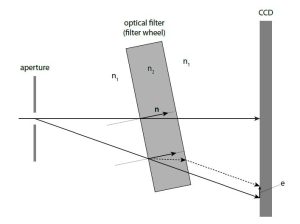Supervisors: Florian Kleber
Status: open
The human eye is sensitive to electromagnetic radiation in a limited range; depending on the amount of radiation entering the retina and individual sensitivity of the observer, a lower bound between 360 nm and 400 nm and an upper bound between 760 nm and 830 nm are assumed.
Multispectral (MS) imaging extends the capabilities of human vision and conventional color photography by providing a finer sampling of the spectrum (i.e., differentiating more spectral bands) and/or including non-visible wavelengths such as ultraviolet (UV) and infrared (IR). An inherent problem of multispectral imaging that is caused by optical dispersion: the refractive indices of materials depend on the wavelength of refracted light. In photography, this effect manifests as chromatic aberrations, leading to both offsets between color channels in the image plane (lateral chromatic aberration) and offsets of their focal planes (longitudinal chromatic aberration). Lateral aberrations, whether caused by dispersion, application of optical filters or other influences, can be corrected in post-processing via conventional image registration procedures. The following Figure shows a lateral chromatic aberration caused by filters.

In this thesis a survey of state-of-the-art registration methods should be presented and analyzed. Based on the outcome a method suitable for Multispectral document images should be selected and developed. The evaluation should be done on public datasets and compared to methods reviewed in the literature. Additionally, the methods should be applied to MSI document images.
The thesis will include the following components:
- Dataset Review and Literature Survey
A comprehensive review of registration methods and available datasets. - Selection of a Registration Approach
Choosing an appropriate method for registration of MSI document images. - Implementation and Evaluation
Developing and testing a system with a graphical interface to visualize the registration highlighting errors. - Written Report and Final Presentation
Completion of the written thesis.
Prerequisites/Helpful Experience
- Proficiency in Python
- Strong understanding of deep learning concepts
- Experience with machine learning frameworks (preferably PyTorch)
